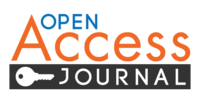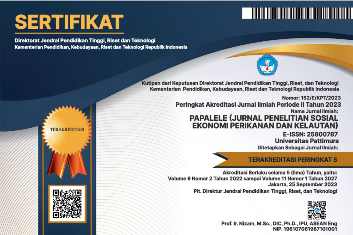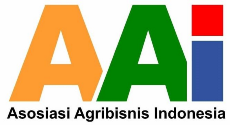STRATEGI PEMBERDAYAN PEMUDA MELALUI BUDIDAYA TIRAM MUTIARA DI NEGERI HATUSUA KECAMATAN KAIRATU
Abstract
Hatusua is a country located in West Seram district and is one of the pearl oyster farming locations. Pearl oyster cultivation in Hatusua country has been around since 2007. The cultivation methods used are KJA and longline methods. Pearl oyster cultivation in the country of Hatusua is also one of the village programs carried out based on the cooperation of the village government with PT Globalindo Mutiara where the company is a company engaged in the fisheries sector, namely pearl shell cultivation. The existing empowerment program requires a more focused development on improving the welfare of the community (youth) without neglecting various aspects, both socio-economic, technical and institutional. The purpose of this paper is to determine youth empowerment development strategies through cultivation of mutaira oysters in Hatusua country. Data analysis using process hierarchy analysis (AHP) includes socio-economic, technical and institutional aspects. Selection of the main criteria chosen by respondents in the AHP assessment based on a comparison of the three main criteria as the most selected criteria for the empowerment strategy were the socio-economic aspects of 41.2% followed by technical aspects of 32.6% and institutional aspects of 26.2%. The combination of the synthesis of the assessment results in the AHP calculation shows that the sequence of the implementation of the youth empowerment strategy is employee wages, family dependents, land suitability, worker skills, land area, business experience, state regulations, government programs, and support from the Marine and fisheries Service.
Downloads
References
Agus, Hary. Christijanto, Kamarijah. Ganef, dan Hari, Budoyo. (2010) Penentuan Insikator Pendekatan Ekosistem Dalam Pengelolaan Perikanan (Ecosystem Approach to Fisheries Management). Bogor: Direktorat Sumberdaya Ikan, Direktorat Jenderal Perikanan Tangkap, Kementerian Kelautan Dan Perikanan, Wwf-Indonesia Dan Pusat Kajian Sumberdaya Pesisir Dan Lautan Institut Pertanian Bogor.
Badan Penanaman Modal Daerah Provinsi Maluku 2011. Analisi usaha budidaya tiram mutiara tahun 2011. Badan Penanaman Modal Daerah Provinsi Maluku, Ambon.
Ehrenberg, Ronald G, 1998. Modern Labour Economic, Scoot and Foresman Company.
Gosling, Elizabeth. 2004. Bivalve Molluscs: Biology, Ecology, And Culture. Fishing News Books, A Division of Blackwell Publishing. Oxford. Isbn-13: 978-0852382349.
Nurani Tw. 2003. Proses Hirarki Analitik: Suatu Metode Pendekatan Untuk Mengatasi Permasalahan-Permasalahan Kompleks Di Bidang Perikanan Dan Kelautan. Bogor: Departemen Pemanfaatan Sumber Daya Perikanan. Ipb.
Saaty Tl. 1991. Decision Making for Leader: The Analytical Hierarchy Process for Decision Complex Word Edisi Bahasa Indonesia (Terjemahan Oleh Ir. Liana S). Jakarta: Pt. Pustaka Binaman Pressindo.
Sinungan. M .1992. Produktivitas Apa Dan Bagaimana. Jakarta Bumi Aksara.
Galparsoro Ibon. 2009. Predicting suitable habitat for the European lobster (Homarus gammarus), on the Basque continental shelf (Bay of Biscay), using EcologicalNiche Factor Analysis. J. ecological modelling 220. 556–567
Muhdi, 2011. wordpress.com/2011/04/27/budidaya-tiram-mutiara-pinctada-maxima.
Witarsa 2015, Model Pengembangan Ekonomi Masyarakat Pesisir Berbasis Co-Management Sumberdaya Perikanan Di Kabupaten Pontianak Jurnal Economia, Volume 11, Nomor 1, April 2015.
Copyright (c) 2020 Milyan Latue, Alex Retraubun, Renoldy L Papilaya

This work is licensed under a Creative Commons Attribution-NonCommercial 4.0 International License.











